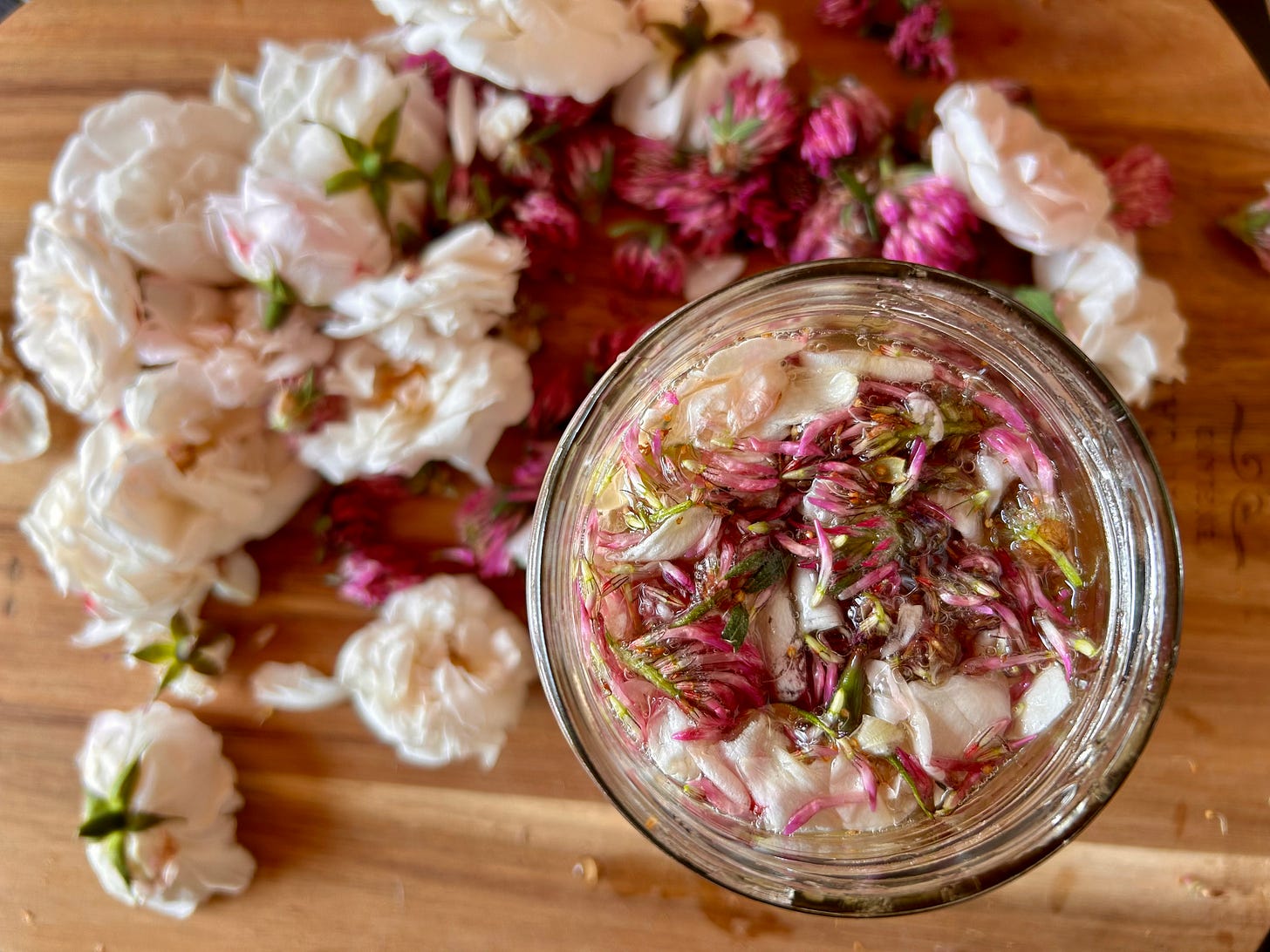I was going to combine this with a Life on the Farm seasonal newsletter, but these roses needed a post of their own. I’ll catch up with early summer on the farm next week. These old-fashioned rambling roses grow feral in the hedgerows around here, and they are blooming rampant, exquisite and plentiful this year. The scent is barely-there delicate, the flavour is heaven.
Harvested this week before the rain along with wild red clover from the wild lands surrounding our farm. Red clovers found in or around agricultural lands are likely agricultural hybrids (bred for heavy yields for forage production)—it’s best picked from way out in the wilds for the real deal Trifolium pratense, if you live somewhere it grows native. I used those with some of the roses in an oxymel, pictured above, which is a honey and vinegar infusion. There’s coherence, synergy, in combining plants that grow from the same soil and offer their harvest under the same sun, each transmuting soil and sunlight into its own concordant assemblage of flavours and nutriment. Oxymel is a really delicious way to preserve the delicate flavours and medicines of summer flowers. Just fill a jar with freshly picked flowers or herb, cover with apple cider vinegar and honey (about half and half), give it a shake and leave to infuse for a few weeks. It’ll keep for months or even years, can be used as food in dressings and the like or taken as a divinely delicious, alcohol-free tincture.
But these sweaty, sun-soaked days of high summer call for soda, so wild rose and sunbeam soda we shall have. This a naturally fermented, “probiotic soda” that harnesses the wild yeasts present on the flowers to give it a light fizz. All you need is honey (or sugar), flowers of your choice, water, and warmth.
In years long past, when I was making up various wildflower champagnes, water kefir, and ginger beer by the bucket and lived in a cold, old house without a south-facing window, and wanted to be sure of a consistent temperature of the warmth required to ferment reliably, whatever the weather was doing, I used the hot press (that’s the airing cupboard for my UK friends, or where your dear old Nan, if she was anything like mine, brewed her wine). And I still would if making up a larger batch of something or I wanted it to sit a bit longer for that lightly alcoholic fizz of a champagne (that is, if I had a hot press in my hut on the hill—oh the small luxuries…). But for small batches of whatever is in season to be guzzled as a refreshing soda, when the sun is out, it’s nice to let the sun do the work and capture the radiance of summer sunbeams in our soda while we’re at it.
The difference between a “champagne” and a soda is basically a second ferment giving you a light alcoholic versus a child-friendly probiotic beverage—both harness the wild yeasts on the plants to ferment the sugars; just with champagne you’re letting some of it go to alcohol. There’s all sorts of recipes out there calling for commercial yeast starters; I have never used a commercial starter and always had wildly delicious results by simply feeding and encouraging the wild yeasts present on the flowers to work their alchemy. I prefer to use honey for wild soda, but I’ll use organic cane sugar when I’m making champagne—it’s going to end up as alcohol anyway. Honey adds its own flavours along with its own strains of wild yeasts if you’re using raw, unfiltered, wildflower honey; sugar will just sweeten and feed the yeasts that are already present on whatever flowers you’re using. Honeysuckle, rose, red clover, and meadowsweet are favourites for either champagne or soda around here—and if I’m feeling bold, valerian flowers make a woozy booze. My current living conditions are not really conducive to reliable booze brewing though, so soda it is.
The recipe is simple:





